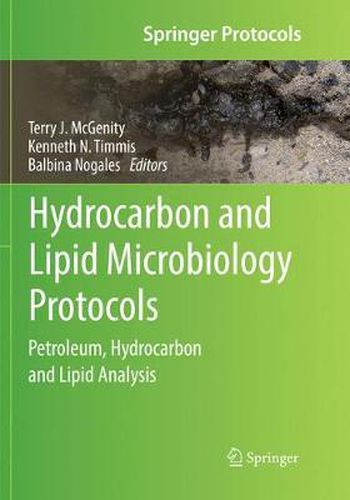Readings Newsletter
Become a Readings Member to make your shopping experience even easier.
Sign in or sign up for free!
You’re not far away from qualifying for FREE standard shipping within Australia
You’ve qualified for FREE standard shipping within Australia
The cart is loading…






This title is printed to order. This book may have been self-published. If so, we cannot guarantee the quality of the content. In the main most books will have gone through the editing process however some may not. We therefore suggest that you be aware of this before ordering this book. If in doubt check either the author or publisher’s details as we are unable to accept any returns unless they are faulty. Please contact us if you have any questions.
This Volume presents methods for analysing and quantifying petroleum, hydrocarbons and lipids, based on their chemical and physical properties as well as their biological effects. It features protocols for extracting hydrocarbons from solid matrices, water and air, and a dedicated chapter focusing on volatile organic compounds. Several approaches for separating and detecting diverse classes of hydrocarbons and lipids are described, including: (tandem) gas chromatography (GC) coupled with mass spectrometry (MS) or flame-ionisation detection, Fourier-transform induction-coupled-resonance MS, and fluorescence-based techniques. The book details high-performance liquid chromatography MS for microbial lipids, as well as a combination of techniques for naphthenic acids. Two chapters focus on quantifying bioavailable hydrocarbon fractions by using cyclodextrin sorbents and bacterial bioreporters, respectively, while a closing chapter explains how compound-specific stable-isotope analysis can be used to measure the fate of hydrocarbons in the environment.
Hydrocarbon and Lipid Microbiology Protocols
There are tens of thousands of structurally different hydrocarbons, hydrocarbon derivatives and lipids, and a wide array of these molecules are required for cells to function. The global hydrocarbon cycle, which is largely driven by microorganisms, has a major impact on our environment and climate. Microbes are responsible for cleaning up the environmental pollution caused by the exploitation of hydrocarbon reservoirs and will also be pivotal in reducing our reliance on fossil fuels by providing biofuels, plastics and industrial chemicals. Gaining an understanding of the relevant functions of the wide range of microbes that produce, consume and modify hydrocarbons and related compounds will be key to responding to these challenges. This comprehensive collection of current and emerging protocols will facilitate acquisition of this understanding and exploitation of useful activities of such microbes.
$9.00 standard shipping within Australia
FREE standard shipping within Australia for orders over $100.00
Express & International shipping calculated at checkout
This title is printed to order. This book may have been self-published. If so, we cannot guarantee the quality of the content. In the main most books will have gone through the editing process however some may not. We therefore suggest that you be aware of this before ordering this book. If in doubt check either the author or publisher’s details as we are unable to accept any returns unless they are faulty. Please contact us if you have any questions.
This Volume presents methods for analysing and quantifying petroleum, hydrocarbons and lipids, based on their chemical and physical properties as well as their biological effects. It features protocols for extracting hydrocarbons from solid matrices, water and air, and a dedicated chapter focusing on volatile organic compounds. Several approaches for separating and detecting diverse classes of hydrocarbons and lipids are described, including: (tandem) gas chromatography (GC) coupled with mass spectrometry (MS) or flame-ionisation detection, Fourier-transform induction-coupled-resonance MS, and fluorescence-based techniques. The book details high-performance liquid chromatography MS for microbial lipids, as well as a combination of techniques for naphthenic acids. Two chapters focus on quantifying bioavailable hydrocarbon fractions by using cyclodextrin sorbents and bacterial bioreporters, respectively, while a closing chapter explains how compound-specific stable-isotope analysis can be used to measure the fate of hydrocarbons in the environment.
Hydrocarbon and Lipid Microbiology Protocols
There are tens of thousands of structurally different hydrocarbons, hydrocarbon derivatives and lipids, and a wide array of these molecules are required for cells to function. The global hydrocarbon cycle, which is largely driven by microorganisms, has a major impact on our environment and climate. Microbes are responsible for cleaning up the environmental pollution caused by the exploitation of hydrocarbon reservoirs and will also be pivotal in reducing our reliance on fossil fuels by providing biofuels, plastics and industrial chemicals. Gaining an understanding of the relevant functions of the wide range of microbes that produce, consume and modify hydrocarbons and related compounds will be key to responding to these challenges. This comprehensive collection of current and emerging protocols will facilitate acquisition of this understanding and exploitation of useful activities of such microbes.